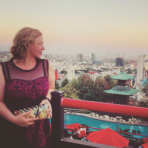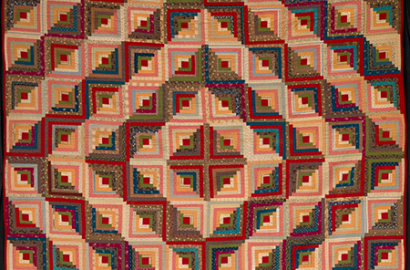Scholars and their obsessions. I heard all about them when I entered graduate school: that professor is obsessed with postcolonial narrative, this professor with film stars and visual culture, another with Victorian poetry. I had my own brief infatuations: with urbanity, transgression, war literature, and some abstract combination of the categories I called “desiring machines,” inspired by Deleuze and Guattari. But in the end, I only had one obsession, one angle.
*
When I recently mentioned my dissertation topic—Los Angeles literature and alternative religion—to a client, he said, “Oh, everyone loves cults.” It’s not the first time I’ve heard this sentiment. I may even share it. The question is why? What is the lure?
*
It might have started for me at the foot of the Hollywood Hills in the mid-1990s when I moved to a studio apartment in a five-story brick building constructed at some point around the advent of the talkie, complete with Murphy bed and built-in vanity. Across the mini-mall parking lot next door, I could see the Church of Scientology Celebrity Centre (ostentatiously using the UK spelling): a gorgeous, stately home for mysterious, possibly sinister events.
When family and friends would visit from the East Coast, I’d pack them in my Mazda and drive the length of Sunset Boulevard, stopping only after we arrived at the Self-Realization Fellowship Lake Shrine a few miles from the coast. We’d wander the grounds and pay homage to all the Los Angeles religions represented there, the small shrines and the origin stories, before I’d relent and take them to the ocean at last.
*
In the mythos of the American frontier, California was the end of the line. A helpful metaphor may be that of the pioneer hitting a wall—in this case, the Pacific—a full stop that marked the final destination where dreams may be realized and spiritual searching fulfilled. The force and flow of all this movement, however, would not dissipate when it reached the obstacle. Instead, manifest destiny would turn backward and inward, the exploration continuing now within the individual. The development of countless new religious movements is evidence of this turn.
*
In 2021, we watch The Path and we watch The Leftovers. We watch Wild Wild Country, we watch Tiger King, and we watch The Vow and its cult companion Seduced. We watch Bikram: Yogi, Guru, Predator and we watch Jesus Camp. We watch Us and we watch Once Upon a Time in Hollywood and we watch The Invitation. We listen to the Cults podcast and the Heaven’s Gate podcast. We read The Incendiaries and The Girls and we read Zero Zone and Educated and Hollywood Park and …
*
Why Los Angeles? Why to this day is it the home of the cult? In 1910, the city had a population of just over 300,000. By 1960, it could claim 2.5 million residents. During this period, Los Angeles was blowing up. Many came to the city looking to change their lives, to find new beginnings or a reimagined set of selves. This new life could include a new religion if they were so inclined. In fact, there was an abundance of religions to choose from. Forget the authority of the church in which they’d been raised—the spirit was theirs for the giving.
*
I blame Nathanael West. Somehow I wound up with the small, blue Signet paperback edition of The Day of the Locust, which still smells of the pungent sweetness of the used bookstore and deliverance. After reading it for the first time, I would never be the same. West’s Los Angeles became my Los Angeles, and I was forever on the lookout for the next promise of salvation.
He visited the “Church of Christ, Physical” where holiness was attained through the constant use of chestweights and spring grips; the “Church Invisible” where fortunes were told and the dead made to find lost objects; the “Tabernacle of the Third Coming” where a woman in male clothing preached the “Crusade Against Salt”; and the “Temple Moderne” under whose glass and chromium roof “Brain Breathing, the Secret of the Aztecs” was taught.
West’s characters desire something outside of themselves, something to justify how they are living. Whether this higher power takes the form of fame, sex, love, money, or Dr. Know-All Pierce-All, what connects them in their misery is both the search for salvation and the repudiation of that search. Earnest or absurd, does Los Angeles draw the fervid? Or does it create them?
*
Los Angeles was populated practically overnight by transplants and migrants who spread out across the vast terrain of the metropolis. This dislocation—geographical or otherwise—encouraged fresh affiliations and spiritual associations. Those who left behind communities with strong religious ties naturally sought kinship in their new city, but the freedom and innovation associated with the California coast inspired risk-taking and new identities.
At the same time, the anxiety of displacement, the hardship of the Depression, and the allure of well-crafted promises from a variety of sects drew lonely and ailing people to invest, both emotionally and financially, in new spiritual enterprises. The film industry also created an aesthetic of unreality that made the drama and spectacle of alternative religions acceptably attractive.
*
In the inevitable way of Hollywood film adaptations, I now have a hard time thinking about The Day of the Locust without seeing Burgess Meredith’s peddling suitcase, Donald Sutherland’s hands, or Karen Black’s lingerie. For ten years, I lived across the street from one of the early Hollywood studios, and when I climbed the stairs to my apartment, I would pass a sign that read “No Agents or Peddlers.” I thought of West each time. Apparently, agents went door-to-door between the wars, trying to steal starlets in short-term rentals away from their current representation.
*
So what are cults, historically speaking? For the most part, a) they have a limited membership in comparison to mainstream religions; b) they introduce a heterodox dogma of some sort that distinguishes them from prior religions; c) they are formed under the auspices of one (usually living) individual or a small group that is responsible for spreading their influence; and d) they originate or assume a new form in the twentieth century. Common features include charismatic leaders, complicated histories and rituals, and secret—or at least vague—doctrines. Some alternative religions got their start in Los Angeles, such as the I AM Movement or The Source. Some began elsewhere but either relocated to Los Angeles or were represented by an important sect, such as Theosophy or the Foursquare Gospel. Some developed fully formed identities in other locations, only to see their leaders, such as Pentecostalism’s Kathryn Kulhman or the Seventh-Day Adventists’ Ellen White, retire to the West Coast.
*
When considering the contemporary fascination people have with cults, I think of my favorite film of 2019, Midsommar. Its director Ari Aster grew up in the Southwest before moving to Hollywood to study film, perhaps also living near the Scientology Celebrity Centre. While Midsommar does not take place in Los Angeles, its pageantry and narrative capture the appeal of some of the city’s most popular religious pursuits.
As an admirer of Aster’s first feature film, Hereditary, I was excited to see what he was up to, so the weekend Midsommar opened, I walked to the Los Feliz 3 triplex theater, got some Red Vines, and settled in. Florence Pugh plays Dani, the girlfriend of a pretty boy grad student in anthropology named Christian. He and his friends have plans to visit Sweden with Pelle, an exchange student in their program, who is traveling home for a solstice festival. The festival has been happening in Pelle’s village for as long as it takes to entrench a ritual as fucked up as the one portrayed in the film.
Dani is traumatized after her sister kills their parents and herself by funneling carbon monoxide into the house. Christian’s friends don’t want her to come to Sweden, but he doesn’t have the heart to tell her, so she tags along, saving her screams for the airplane bathroom. Once they arrive at the village, we discover that it is home to a full-on pastoral homicide cult, and Aster takes us on a glorious and horrific journey.
(I have a theory that the cultish end of Hereditary is just a preview of the film Aster really wanted to make: Midsommar.)
*
As Southern California became a destination in the nineteenth century, the conception and reality of the frontier was instrumental in encouraging religious fervor. Many prospectors and other settlers from both within and without the United States left behind not only family and roots but also religious ritual and a sense of community. What many seekers found in the variety of religions offered in Los Angeles was a choice of prescribed recipes for transformation. For the immigrant at the end of the frontier, reinvention was the one remaining direction of limitless possibility, although as Carolyn See has pointed out: “You get what you want, then what?”
*
Midsommar is just one pop culture example of our current fascination with the acceptable attraction of cults, a cinematic extension that hearkens back to an earlier cult classic, The Wicker Man. Each individual in Midsommar has different motivations drawing them to Hårga, the ancestral commune behind the solstice festival; they occupy various positions on the spectrum from repulsed to intrigued to entranced. One of the most entertaining subplots—and, as a former grad student, also horrific in its own way—is the intellectual property battle between Christian and a character named Josh, who has traveled to Sweden because of his anthropological and academic interest in the commune’s rituals. Or I should say, Josh’s interest is usurped by the unfocused and unoriginal Christian in yet another occurrence of a white man’s appropriation of a Black man’s ideas.
*
In the 1953 film adaptation of H.G. Wells’s The War of the Worlds, aliens come to Earth, bent on human destruction. Southern California stands in for the world when an alien spaceship crashes in a small town called Linda Rosa. Representing two poles of the region’s industry and energy—science and religion—a “Pacific Tech” scientist and a minister’s niece team up to combat the invasion. When the minister tries to intervene and convince the aliens to accept a peaceful resolution, he is vaporized. Scenes in Los Angeles show the chaos overtaking Earth, complete with a riot on the downtown streets. The aliens are eventually annihilated, not by military intervention or high-tech weaponry, but by a bacteria that spreads lethally through their population.
One of the final scenes of the film is most relevant to us here: when the aliens appear indestructible and the end of humanity seems imminent, people flee in droves to their nearest church, the last sanctuary of the apocalyptically threatened. This link between the end of the world and the overwhelming need for spiritual solace recurs continually through the canon of Los Angeles literature. The apocalypse is both feared, an anxiety inspired by the ongoing instability of the landscape, and desired by those seeking further spiritual frontiers and a long-deferred meeting with their maker.
*
In a recent conversation about this cult attraction, I asked a friend what he thought drew people to alternative religions. He spoke of the intensity of belief, its magnetism, and how like a whirlpool or riptide, the pull of devotion and fervor could cause people to forfeit their former spiritual affiliations and abscond from their lives despite the loss or destruction that would be left in their wake. The power of the belief is its own seduction.
“Don’t you think?” he asked.
I considered his explanation for a moment.
“I think it would be relaxing,” I said.
*
There’s no single reason that acolytes are drawn to cults. Some need to feel special and appreciated, recognized in some way for their capacity to understand; some need to belong inside a frame, to exist in opposition to those outside; some search for the final lifehack that will fix all the bugs that are really features; some are captivated by the theatre of it; some are lured by the promise of easy sex, because honestly, what good is a cult without easy sex?
In Midsommar, Christian is approved to mate with a character named Maja on a bed of flowers while the naked village women chant over them. One elder even joins in, pushing Christian from behind as he thrusts. That is all it takes, beyond the water with “special properties” he imbibed beforehand, for him to toss everything away.
*
But what about the view from the outside? Why are we so interested in watching people join cults?
On one hand, it’s largely vicarious. We can imagine what it would feel like to belong, to reap the free love, to eschew our responsibilities as autonomous beings. We can also imagine what it might be like to be the cult leader—a position that is largely about power and abuse of that power, but of course, we would be benevolent leaders. Has there ever been a leader who didn’t tell themselves that there was some benevolence behind their power?
On the other hand, it’s drama. Drama we can consume from a distance and enjoy as much as any other form of entertainment predicated on someone else’s confusion and pain.
Sometimes it’s even comedy.
*
In looking at various new religious movements in Los Angeles during the twentieth century—spiritualism and Scientology, Theosophy and the Church of the Nazarene, the Vedanta Society and Pentecostalism, the Self-Realization Fellowship and the Seventh-Day Adventists, Kabbalah and the Jesus People—we can see that the spiritual landscape of the city was both a forerunner and a response to religious changes occurring across the nation. Because of the character of religious pluralism in the city, new movements often had to distinguish themselves through extreme narratives of salvation or demonstrate their marked reinterpretation of the established faith from which they originated. “California,” historian Charles A. Fracchia once observed, “is the laboratory—the ‘great crucible,’ so to speak, where new religious forms are being forged.”
*
I live north of downtown Los Angeles, in an area that is home to the Scientology West Coast Headquarters, Scientology Media Productions, the Scientology Celebrity Centre, and the Scientology-sponsored Psychiatry: An Industry of Death Museum. Frequently, I use the Headquarters campus to turn around while looking for parking along Fountain Avenue; I dismiss proselytizers in matching vests when I am on my way to doctors’ offices at Kaiser Permanente; I stand in line to order lattes behind polo-wearing Sea-Org members at cafes in Los Feliz.
My neighbors and I live amidst what is likely the largest cult on earth and—despite the horror stories in Lawrence Wright’s Going Clear and Leah Remini’s Scientology and the Aftermath—we go about our business as its members go about theirs. Did Scientology manage to escape the vilification reserved for Charles Manson or Jonestown because their religion is so uncomfortably strange? Perhaps Scientology is perfectly poised to embody the shrapnel at the end of the frontier.
*
Scientology represents a throwback to the way alternative religions used to function in Los Angeles: buying property, attracting celebrities, and selling success—be it spiritual or material—to their members. In the 1960s, the rise of counterculture ideology led to an emphasis on youth and, with the 1969 murders by the Manson Family, an emphasis on danger. Manson really turned the tables. The cults we imagine or witness today are informed by him and the violence he inspired. Helter Skelter and Jonestown broke open the possibility of annihilation at the hands of cults, which has taken its most deadly forms in places like Waco and in groups like Heaven’s Gate.
Once the anti-cult movement got under way in the 1960s, the word “cult” itself became a term of opprobrium. For the cults of pre-1960 Los Angeles, the emphasis was on reinvention and community, no matter how nonsensical or detrimental the form.
*
In a turbulent environment like America in the 1930s (or now), new religious movements that emphasized the strength of the individual within the structure of an organized community provided, simultaneously, a sense of belonging in an era of collectivism and an escape from the pressures of historical reality. Peter Washington describes how the religious leader of the 1930s addressed the political climate of the era by focusing on the individual instead, “claiming, indeed, that it was only through individuals that any real change could take place in the world, and that it was worse than useless to address problems at the political level.” Disenchantment is required for conversion. The gurus supplied the criticism and the path to the “realization of possibilities,” an open market economy for spiritual salvation.
*
Throughout the twentieth century and into the twenty-first, dreams are dashed and in need of constant replacement. A longing for health or fame, love or money, if not replaced by a new messiah, can be converted into a desire for havoc. Thus, the attraction of any spiritual path: a way to make sense of exile and displacement, which are, of course, common human conditions. A way to make sense of how we live.
Faced with ideas of apocalypse and a landscape of aggression, the early residents of Los Angeles often used the search for salvation as a way to ground themselves in a new identity, a complicated pursuit in what may have seemed to them a city at the end of the world. Today, in what may be a world at the end of the world, it’s equally urgent to reconsider the appeal of the cult and find something else to love.


